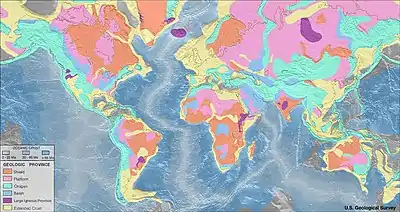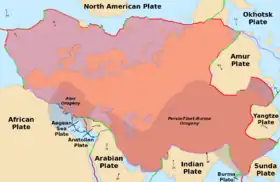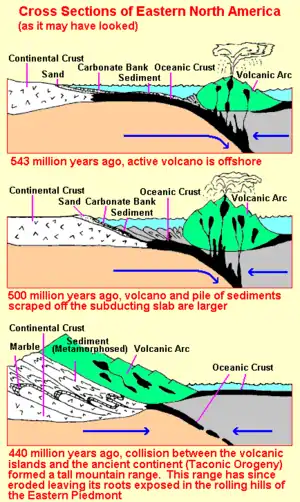List of orogenies
The following is a list of known orogenies organised by continent, starting with the oldest at the top. The organization of this article is along present-day continents that do not necessarily reflect the geography contemporary to the orogenies. Note that some orogenies encompass more than one continent and might have different names in each continent. Likewise some very large orogenies include a number of sub-orogenies. As with other geological phenomena orogenies are often subject to different and changing interpretations regarding to their age, type and associated paleogeography.

African orogenies
- Pan-African orogeny – Series of major Neoproterozoic orogenic events which related to the formation of the supercontinents Gondwana and Pannotia, Neoproterozoic Era (550 Ma)
- Damara orogeny – Mountain building event at the intersection of the Congo and the Kalahari cratons.
- Kibaran orogeny – Mountain building event in what is now Africa
- Eburnean orogeny – Mountain building event in what is now West Africa
- East African Orogeny – Main stage in the Neoproterozoic assembly of East and West Gondwana
- Mauritanide Orogeny – Ancient orogen parallel to the west coast of Africa from Morocco to Guinea-Bissau
- Mozambique Orogeny – Band in the earth's crust from East Antarctica through East Africa up to the Arabian-Nubian Shield
- Zambezian Orogeny – Area of mountain building now in southern Zambia and northern Zimbabwe
Antarctic orogenies
Orogenies affecting Antarctica include:[1]
- Napier orogeny – (4000±200 Ma)
- Rayner orogeny – (c. 3500 Ma)
- Humboldt orogeny – Geologic formation in Antarctica, (c. 3000 Ma)
- Insel orogeny – (2650±150 Ma)
- Early Ruker orogeny – (2000–1700 Ma)
- Late Ruker orogeny, also known as the Nimrod orogeny – (1000±150 Ma)
- Beardmore orogeny – (633–620 Ma)
- Ross orogeny – Paleozoic mountain building event in Antarctica – (c. 550 – c. 480 Ma)
- Borchgrevink orogeny
- Peninsula orogeny
Asian orogenies

Persia–Tibet–Burma orogeny in Eurasian Plate
- Aravalli-Delhi Orogen – Precambrian
- Altaid Orogeny – Paleozoic Era
- Uralian orogeny – Long series of linear deformation and mountain building events that raised the Ural Mountains, during the Permian Period
- Cimmerian and Cathaysian orogenies
- Dabie-Sulu orogeny – Mesozoic Era
- Persia–Tibet–Burma orogeny – Cenozoic Era; caused by the continuing collision of the Arabian and Indian Plates with the Eurasian Plate, encompassing:
- Himalayan orogeny – Forming the Himalaya Mountains
European orogenies
- Saamian orogeny – Formation of an extensive area of tonalitic-trondhjemitic crust in Fennoscandia, (3.1–2.9 Ga)
- Lopian orogeny – Archean orogeny – Formation of two different types of terrain compatible with plate tectonic concepts. One is a belt of high-grade gneisses formed in a regime of strong mobility, while the other is a region of granitoid intrusions and greenstone belts surrounded by the remnants of a Saamian substratum, (2.9–2.6 Ga)
- Svecofennian orogeny, also known as Svecokarelian orogeny – Geological process that resulted in formation of continental crust in Sweden, Finland and Russia, (2.0–1.75 Ga)
- Gothian orogeny – Formation of tonalitic-granodioritic plutonic rocks and calc-alkaline volcanites (like the previous Svecofennian orogeny), (1.75–1.5 Ga)
- Sveconorwegian orogeny – Orogenic belt in southwestern Sweden and southern Norway – Essentially reworking of previously formed crust, (1.25 Ga – 900 Ma)
- Timanide orogeny – Affecting the northern Baltic Shield during the Neoproterozoic Era, (620–550 Ma)
- Cadomian orogeny – On the north coast of Armorica in the Ediacaran/Cambrian, (660–540 Ma)
- Caledonian orogeny – Mountain building event caused by the collision of Laurentia, Baltica and Avalonia – Deformation of the western Scandinavian Peninsula, Britain and Ireland, in the Ordovician Grampian phase and the Silurian Scandian phase[2]
- Variscan orogeny, also known as Hercynian orogeny – Collision of tectonic plates resulting in the creation of mountains – Deformation in western Iberia, southwest Ireland, southwest England, central and western France, southern Germany and Czech Republic, during the Devonian and Carboniferous Periods
- Uralian orogeny – Long series of linear deformation and mountain building events that raised the Ural Mountains, during the Permian Period.
- Alpine orogeny – Formation of the Alpine mountain ranges of Europe, the Middle East and northwest Africa, encompassing:
- The Formation of the Alps, during the Eocene through Miocene Periods
- Carpathian orogeny – Building the Carpathian Mountains of eastern Europe, during the Jurassic-Cretaceous to Miocene Period
- Hellenic orogeny – In Greece and the Aegean area, during Eocene through Miocene Periods
- Mediterranean Ridge – Seabed ridge south of Greece
North American orogenies

Taconic orogeny
- Algoman orogeny, also known as Kenoran orogeny – Late Archaean episode of mountain building in what is now North America – Superior province, South Dakota to Lake Huron, late Archean Eon (2700–2500 Ma)
- Wopmay orogeny – Mountain-building event in northern Canada – Along western edge of Canadian shield, (2100–1900 Ma)
- Trans-Hudson orogeny, also known as Hudsonian orogeny – Mountain-building event in North America – Extends from Hudson Bay west into Saskatchewan then south through the western Dakotas and Nebraska. Result of the collision of the Superior craton with the Hearne craton and the Wyoming craton, during the Proterozoic Eon (2000–1800 Ma)
- Nagssugtoqidian orogeny – Late Paleoproterozoic mountain-building event in Greenland – (1910–1770 Ma)
- Ketilidian orogeny – Collision at the southern margin of the North Atlantic Craton, late Paleoproterozoic Era (1850–1720 Ma)
- Penokean orogeny – Wisconsin, Minnesota, Michigan, and southern Ontario, (1850–1840 Ma)
- Great Falls orogeny, also known as the Big Sky orogeny – Proterozoic collision between the Hearne craton and the Wyoming craton in southwest Montana, (1770 Ma)
- Ivanpah orogeny – Mojave region, south western U.S.
- Yavapai orogeny – Mountain building event 1.7 billion years ago in the southerwestern United States, (1710–1700 Ma)
- Mazatzal orogeny – Mountain-building event in North America – Mid to south western U.S., (1675–1650 Ma)
- Picuris orogeny – Mid to south western U.S., (1430–1300 Ma)
- Grenville orogeny – Mesoproterozoic mountain-building event – Worldwide, during the late Proterozoic Eon (1300–1000 Ma). Associated with the assembly of the supercontinent Rodinia. Formed folded mountains in eastern North America from Newfoundland to North Carolina, (1100–1000 Ma)
- Caledonian orogeny – Mountain building event caused by the collision of Laurentia, Baltica and Avalonia, including:
- East Greenland Orogen – From Cryogenian to Devonian Periods
- Taconic phase – Mountain-building period that affected most of New England – In the northeastern U.S. and Canada, during the Ordovician Period
- Acadian phase – North American orogeny – In the eastern U.S., during the Silurian and Devonian Periods
- Appalachian orogeny – Mountain-forming event that formed the Appalachian and Allegheny Mountains – Usually seen as the same as the Variscan orogeny in Europe
- Appalachian Mountains is a well studied orogenic belt resulting from a late Paleozoic collision between North America and Africa.
- Taconic orogeny – Mountain-building period that affected most of New England
- Acadian orogeny – North American orogeny
- Alleghanian orogeny – Mountain-forming event that formed the Appalachian and Allegheny Mountains
- Ouachita orogeny – Mountain-building event that resulted in the Ouachita Mountains Ouachita Mountains of Arkansas and Oklahoma is an orogenic belt that dates from the late Paleozoic Era and is most likely a continuation of the Appalachian orogeny west across the Mississippi embayment – Reelfoot Rift zone.
- Antler orogeny – Ancestral Sierra Nevada, western U.S., from late Devonian Period to early Mississippian age
- Innuitian orogeny, also known as Ellesmerian orogeny – Major tectonic episode in the Canadian Arctic and Northernmost Greenland – Innuitian Mountains, Canadian Arctic, extending from Ellesmere Island to Melville Island, Mississippian age (345 Ma)
- Sonoma orogeny – Rocky Mountains, western North America, (270–240 Ma)
- Nevadan orogeny – Developed along western North America, during the Jurassic Period
- Sevier orogeny – Mountain-building episode in North America – Rocky Mountains, western North America, (140–50 Ma)
- Laramide orogeny – Period of mountain building in western North America, which started in the Late Cretaceous – Rocky Mountains, western North America, (40–70 Ma)
- Pasadena orogeny – Transverse Ranges, western North America, Pleistocene Period to present day
Oceania orogenies
Australian orogenies
- Sleaford orogeny – Gawler Craton, South Australia, (2440–2420 Ma)
- Glenburgh orogeny – Glenburgh Terrane, Western Australia, (c. 2005–1920 Ma)
- Barramundi orogeny – MacArthur Basin, northern Australia, (c. 1890–1850 Ma)
- Kimban orogeny – Gawler Craton, South Australia, (c. 1845–1700 Ma)
- Cornian orogeny – Gawler Craton, South Australia
- Miltalie orogeny – Gawler Craton, South Australia
- Yapungku orogeny – North Yilgarn craton margin, Western Australia, (c. 1765 Ma)
- Albany-Fraser orogeny – Western Australia, (c. 1710–1020 Ma)
- Mangaroon orogeny – Gascoyne Complex, Western Australia, (c. 1680–1620 Ma)
- Isan orogeny – Mount Isa Block, Queensland, (c. 1600 Ma)
- Kararan orogeny – Gawler Craton, South Australia, (1570–1555 Ma)
- Olarian orogeny – Olary Block, South Australia
- Capricorn orogeny – Gascoyne Complex, Western Australia
- Musgrave orogeny – Musgrave Block, Central Australia, (c. 1080 Ma)
- Edmundian orogeny – Gascoyne Complex, Western Australia, (c. 920–850 Ma)
- Petermann orogeny – Central Australia, late Neoproterozoic Era to Cambrian Period (c. 550–535 Ma)
- Delamerian Orogeny – South Australia and Victoria, Ordovician Period, (c. 514–510 Ma)
- Lachlan Orogeny – Victoria and New South Wales, (c. 540 and 440 Ma)
- Thomson Orogeny – Northern continuation of the Lachlan Orogeny
- Alice Springs Orogeny) – Central Australia, early Carboniferous Period, (450–300 Ma)
- Kanimblan Orogeny – Victoria and New South Wales, Carboniferous Period (c. 318 Ma)
- Hunter-Bowen orogeny, also known as New England Orogeny – Queensland and New South Wales, Permian Period to Triassic Period (c. 260–225 Ma)
New Zealand orogenies
- Tuhua Orogeny, (370–330 Ma)
- Rangitata Orogeny, (142–99 Ma)
- Kaikoura Orogeny, (24 Ma – present)
South American orogenies
- Transamazonian orogeny – Paleoproterozoic[3]
- Guriense orogeny
- Sunsás orogeny
- Cariri Velhos orogeny
- Brasiliano-Pan African orogeny – Brasilia Belt
- Pampean orogeny – Paraguai Belt
- Chonide orogeny
- Terra Australis Orogeny
- Pampean orogeny
- Famatinian orogeny – Paleolithic geological event in South America
- San Rafael orogeny
- Gondwanide orogeny – Permian mountain forming tectonic event – Sierra de la Ventana
- Toco orogeny, Chilean Coast Range, (300–330 Ma)[4]
- Andean orogeny – Ongoing mountain-forming process in South America, Andes Mountains, (200 Ma – present)
References
- "Archived copy". Archived from the original on 2008-10-19. Retrieved 2010-11-26.
{{cite web}}: CS1 maint: archived copy as title (link) Tectonics of the Transantarctic Mountains: Geochronology - Strachan, R.A.; Smith, M.; Harris, A.L.; Fettes, D.J. (2002). "4: The Northern Highland and Grampian terranes". In Trewin N.H. (ed.). The Geology of Scotland. Geological Society, London. ISBN 978-1-86239-126-0.
- Alkmima, Fernando F. and Stephen Marshak; Transamazonian Orogeny in the Southern São Francisco Craton Region, Minas Gerais, Brazil: evidence for Paleoproterozoic collision and collapse in the Quadrilátero Ferrífero, Precambrian Research, Volume 90, Issues 1–2, 30 June 1998, Pages 29–58
- The Geology of Chile Teresa Moreno, Wes Gibbons, Geological Society of London
This article is issued from Wikipedia. The text is licensed under Creative Commons - Attribution - Sharealike. Additional terms may apply for the media files.